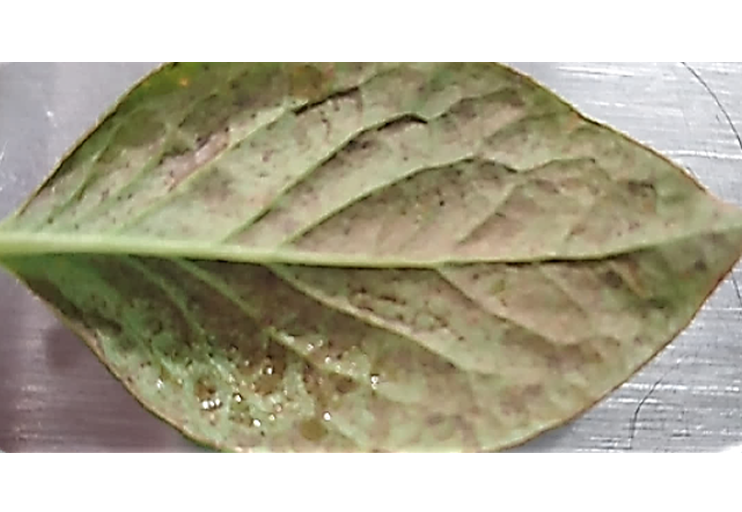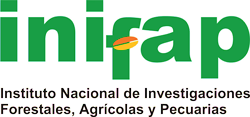Arthropods associated with blueberries and their link to bud abortion
DOI:
https://doi.org/10.29312/remexca.v16i4.3703Keywords:
Brevipalpus yothersi, Scirtothrips dorsalis, Vaccinium corymbosumAbstract
In order to describe the arthropod fauna associated with blueberry crops and consider its potential link with bud abortion, a study of the taxa present during a phenological cycle of the crop was carried out in a blueberry orchard, Biloxi variety, in Los Reyes, Michoacán, Mexico, from October to February 2022; the recorded taxa were identified and their potential link with bud abortion was assessed. Seven different taxa of arthropods were found, of which the presence of the following stands out: Brevipalpus yothersi Baker (Acari: Tenuipalpidae), which is reported as a virus vector, and Scirtothrips dorsalis Hood (Thysanoptera: Thripidae), due to the damage it causes from the vegetative phase. The analysis indicated that S. dorsalis is a taxon that is present from the first vegetative shoots, whereas B. yothersi increases its population level significantly when the crop enters the phenological phase of flowering. Based on the characteristics of both pests, it is considered that the simultaneous presence of S. dorsalis and B. yothersi could be the cause of the phytosanitary problem observed in blueberries.
Downloads
References
Aguilar-Piedra, H. y Solano-Guevara, A. M. 2020. Nuevos hospederos y registros de ácaros fitófagos para Costa Rica: período 2013-2018. Agronomía Costarricense. 44(1):9-28. https://dx.doi.org/10.15517/rac.v44i1.39996.
Ayala-Ortega, J. D. J.; Martínez-Castillo, A. M.; Pineda-Guillermo, S.; Figueroa-Rosa, J. I.; Acuña-Soto, J.; Ramos-Lima, M. y Vargas-Sandoval, M. 2019. Ácaros asociados a la zarzamora (Rubus sp. cv. Tupy) en dos localidades del estado de Michoacán, México. Revista Colombiana de Entomología. 45(2):e84-80:1-10. https://doi.org/10.25100/socolen.v45i2.8480.
Bastidas, J.; Devia, D. y Santos, O. 2010. Cría y evaluación de la capacidad de depredación de Chrysoperla externa sobre Neohydatothrips signifer, trips plaga del cultivo de maracuyá. Revista Corpoica Ciencia y Tecnología Agropecuarias. 11(1):31-40. https://www.redalyc.org/articulo.oa?id=449945028004 .
Beard, J. J.; Ochoa, R.; Braswell, W. E. and Bauchan, G. 2015. Brevipalpus phoenicis (Geijskes) species complex (Acari: Tenuipalpidae) a closer look. Zootaxa, 3944. 67 p.
Cervantes-Mayagoitia, J. F. y Huacuja-Zamudio, A. H. 2020. Guía de los ácaros e insectos herbívoros de México. Ácaros e insectos antófagos y carpófagos de importancia agrícola y forestal. Serie Académicos. 4(143):29-37. https://casadelibrosabiertos.uam.mx/contenido/contenido/Libroelectronico/acaros-4.pdf.
Chant, D. A. and Murtry, J. A. 2007. A review of the subfamily Amblyseiinae Muma (Acari: Phytoseiidae): part 6. The tribe euseiini n. Tribe, subtribes Typhlodromalina n. subtribe, Euseiina n. subtribe, and Ricoseiina n. subtribe. International Journal of Acarology. 31(3):187-224. Doi.org/10.1080/01647950508684424 .
Childers, C. C.; French, J. V. and Rodrigues, J. C. V. 2003. Brevipalpus californicus, B. obovatus, B. phoenicis and B. lewisi (Acari: tenuipalpidae): a review of their biology, feeding injury and economic importance. Experimental and applied acarology. 30:5-28. Doi.org/10.1023/B:APPA.0000006543.34042.b4.
Cromroy, H. L. and Kuitert, L. C. 2017. Blueberry bud mite, Acalitus vaccinii (Keifer) (Arachnida: Acari: Eriophyidae). UF. IFAS Extension. EENY-186. https://edis.ifas.ufl.edu/pdffiles/IN/IN34300.pdf.
Domínguez-Gabriel, J.; Guillén-Navarro, K.; Otero-Colina, G.; Valle-Mora, J. and González-Gómez, R. 2021. Brevipalpus mites associated with coffee plants (Coffea arabica and C. canephora) in Chiapas, Mexico. Exp Appl Acarol. 85:1-17. https://doi.org/10.1007/s10493-021-00657-9.
Krantz, G. W. and Walter, D. E. 2009. A manual of acarology. 3rd Ed. Texas Tech University Press, Lubbock. ISBN 9780896726208. 809 p.
Larraín, P.; Salas, C. F. y Graña, F. 2007. Plagas del arándano y generalidades de manejo. Agricultura Limpia. 16-20 pp. https://biblioteca.inia.cl/bitstream/handle/20.500.14001/6372/NR34772.pdf?sequence=1&isAllowed=y.
Lindquist, E. E. 1986. The world genera of Tarsonemidae (Acari: heterostigmata): a morphological, phylogenetic, and systematic revision, with a reclassification of family group taxa in the heterostigmata. Memoirs of the Entomological Society of Canada. 517 p. https://doi.org/10.4039/entm118136fv.
Mondragón-Flores, A.; López-Medina, J.; Ochoa-Ascencio, S. y Gutiérrez-Contreras, M. 2012. Hongos asociados a la parte aérea del arándano en los Reyes, Michoacán, México. Revista Mexicana de Fitopatología. 30(2):141-144. https://www.smf.org.mx/rmf/DocumentosVolumenes/Escrito-30-2-4.pdf.
Murillo-Rojas, P. y Aguilar-Piedra, H. 2021. Principales ácaros encontrados en laboratorios comerciales de cultivo de tejidos vegetales y su asociación con hongos en el Valle Central de Costa Rica. Agronomía Costarricense. 45(1):41-52. http://www.scielo.sa.cr/scielo.php?script=sci-arttext&pid=S037794242021000100041&lng=en&tlng=es.
Ortiz, J. A.; Infante, F.; Rodríguez, D. and Toledo-Hernández, R. A. 2020. Discovery of Scirtothrips dorsalis (Thysanoptera: Thripidae) in blueberry fields of Michoacan, Mexico. Florida Entomologist. 103(3):408-410. Doi:10.1653/024.103.0316.
Ramos-Lima, M.; Ayala-Ortega, J. J.; Lara-Chávez, B. N. y Vargas-Sandoval, M. 2021. Registro de Euseius consors (Acari: phytoseiidae) en aguacates de Michoacán, México. Revista Colombiana de Entomología. 47(2):e10243. https://doi.org/10.25100/socolen.v47i2.10243.
Salgado Vargas, C.; Sánchez-García, P.; Volke-Haller, V. H. y Colinas-León, M. T. B. 2018. Respuesta agronómica de arándano (Vaccinium corymbosum L.) al estrés osmótico. Agrociencia. 52(2):231-239. http://www.scielo.org.mx/scielo.php?script=sci-arttext&pid=S140531952018000200231&lng=es&tlng=es.
Vera, M. A.; Acosta, G.; Murúa, M. G.; Casmuz, A. S. y Fadda, L. 2018. Plagas no blanco de la soja Bt: complejo de especies del género Spodoptera Guenée. 1852 (Lepidoptera: Noctuidae); Estación Experimental Agroindustrial Obispo Colombres; Avance Agroindustrial. 39:3-9. https://ri.conicet.gov.ar/handle/11336/95741.

Published
How to Cite
Issue
Section
License
Copyright (c) 2025 Revista Mexicana de Ciencias Agrícolas

This work is licensed under a Creative Commons Attribution-NonCommercial 4.0 International License.
The authors who publish in Revista Mexicana de Ciencias Agrícolas accept the following conditions:
In accordance with copyright laws, Revista Mexicana de Ciencias Agrícolas recognizes and respects the authors’ moral right and ownership of property rights which will be transferred to the journal for dissemination in open access. Invariably, all the authors have to sign a letter of transfer of property rights and of originality of the article to Instituto Nacional de Investigaciones Forestales, Agrícolas y Pecuarias (INIFAP) [National Institute of Forestry, Agricultural and Livestock Research]. The author(s) must pay a fee for the reception of articles before proceeding to editorial review.
All the texts published by Revista Mexicana de Ciencias Agrícolas —with no exception— are distributed under a Creative Commons License Attribution-NonCommercial 4.0 International (CC BY-NC 4.0), which allows third parties to use the publication as long as the work’s authorship and its first publication in this journal are mentioned.
The author(s) can enter into independent and additional contractual agreements for the nonexclusive distribution of the version of the article published in Revista Mexicana de Ciencias Agrícolas (for example include it into an institutional repository or publish it in a book) as long as it is clearly and explicitly indicated that the work was published for the first time in Revista Mexicana de Ciencias Agrícolas.
For all the above, the authors shall send the Letter-transfer of Property Rights for the first publication duly filled in and signed by the author(s). This form must be sent as a PDF file to: revista_atm@yahoo.com.mx; cienciasagricola@inifap.gob.mx; remexca2017@gmail.
This work is licensed under a Creative Commons Attribution-Noncommercial 4.0 International license.


